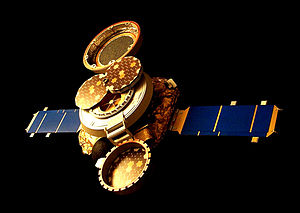Genesis (spacecraft)

In its collecting configuration, the Genesis spacecraft exposed several types of solar wind collectors, as well as ion and electron monitors.
|
|
| Mission type | Sample return mission |
|---|---|
| Operator | NASA · JPL |
| COSPAR ID | 2001-034A |
| SATCAT № | 26884 |
| Website | genesismission |
| Spacecraft properties | |
| Manufacturer | Lockheed Martin Space Systems |
| Dry mass | 494 kilograms (1,089 lb) |
| Power | 254 W (Solar array / Ni-H2 battery) |
| Start of mission | |
| Launch date | August 8, 2001 16:13:40 UTC (15 years, 6 months and 1 day ago) |
| Rocket | Delta II 7326 |
| Launch site | Cape Canaveral SLC-17 |
| End of mission | |
| Landing date | September 8, 2004, after 16:55 UTC (12 years, 5 months and 1 day ago) |
| Landing site |
Dugway Proving Ground, Utah 40°11′19″N 113°12′46″W / 40.18861°N 113.21278°W |
|
|
|

Mission patch for Genesis personnel participating in the sample return phase of the mission in September 2004.
Genesis was a NASA sample return probe that collected a sample of solar wind and returned it to Earth for analysis. It was the first NASA sample return mission to return material since the Apollo Program, and the first to return material from beyond the orbit of the Moon.Genesis was launched on August 8, 2001, and crash-landed in Utah on September 8, 2004, after a design flaw prevented the deployment of its drogue parachute. The crash contaminated many of the sample collectors, and although most were damaged, some of the collectors were successfully recovered.
The Genesis science team demonstrated that some of the contamination could be removed or avoided, and that the solar wind could be analyzed using a variety of approaches, achieving all of the mission's major science objectives.
The mission's primary science objectives were:
Note that the mission's science objectives refer to the composition of the Sun, not that of the solar wind. Scientists desire a sample of the Sun because evidence suggests that the outer layer of the Sun preserves the composition of the early solar nebula. Therefore, knowing the elemental and isotopic composition of the outer layer of the Sun is effectively the same as knowing the elemental and isotopic composition of the solar nebula. The data can be used to model how planets and other Solar System objects formed, and then extend those results to understanding stellar evolution and the formation of planetary systems elsewhere in the universe.
...
Wikipedia
